Infectious diseases. Later, acute, surgical, psychogeriatric
The Mogden Isolation Hospital was officially opened in July 1898 by the Duke of Cambridge. It had been established by the Boroughs of Richmond (Surrey) and Heston & Isleworth Urban District Joint Isolation Hospital Committee for the treatment and care of patients with scarlet fever, diphtheria, enteric fever, measles and other infectious diseases. It partially replaced the Dockwell Isolation Hospital in Cranford (in the parish of Heston), which was retained as a smallpox hospital.
The Hospital consisted of four separate single-storey blocks, each containing a ward. Two of these, each with 24 beds in cubicles, were in a horseshoe-form facing south, while the other two blocks were straight - one with cubicles and one an open ward. The main kitchen was enormous and could cater for 1,000 people. The Nurses' Home was large and magnificent, but lacked homeliness.
In 1935 the Joint Isolation Hospital Committee ceased to exist and the South Middlesex and Richmond Joint Hospital Board took over control of the Mogden, Twickenham and Hampton Isolation Hospitals. All acute cases were sent to Mogden.
In 1938 an administration block and a laboratory were built and the wards were modernised. The Hospital was renamed the South Middlesex Fever Hospital.
In 1939, at the outbreak of WW2, the large pavilion wards were taken over by the Emergency Medical Service (EMS). Extra beds were provided by the Ministry of Health, so that the Hospital had 227 beds available for the anticipated casualties; 96 beds in the cubicle wards remained available for infectious patients. Resident medical staff were seconded from St George's Hospital and the West London Hospital. Extra nurses, clerical and domestic staff were transferred from the Westminster and other London hospitals. The Hospital was renamed the South Middlesex EMS Hospital for the duration of the war. In October 1940 some 26 beds were set aside for gynaecological patients from the Chelsea Hospital for Women requiring surgery. This work expanded during 1941 and, in 1942, 302 gynaecological cases were treated.
In 1947, following epidemics of measles and polio, there was a substantial increase in admissions, including patients from Acton.
The Hospital joined the NHS in 1948, under the control of the South West Middlesex Group Hospital Management Committee, part of the North West Metropolitan Regional Hospital Board. It was renamed the South Middlesex Hospital, dealing with acute and infectious diseases.
In 1952 the wards were redecorated internally in a peach, cream and grey colour scheme. The ward furniture was was renovated and repainted in contrasting colours of blue, green and pink. Glazed sashes replaced the corrugated iron sheeting along the corridors linking the wards. Swing doors to wards were installed, and the operating theatre and the side wards were also redecorated. However, due to the difficulty in attracting qualified nursing staff, nursing orderlies were employed instead.
By 1953 the Hospital had 144 beds, of which only 83 were in use because of the shortage of nursing staff. One ward was closed, while two cubicle wards were reserved for fever patients. The fourth (open) ward with 24 beds was the surgical ward used by Mr. Robert Galloway, Medical Director of the West Middlesex Hospital. The operating theatre adjoined one of the horseshoe wards.
In 1955 one of the smaller buildings was converted into an Ophthalmic Department, with its own operating theatre. It became the Regional Eye Unit.
In 1960, when improvement works began at the Queen Mary Maternity Wing at the West Middlesex Hospital, the maternity patients took over the gynaecological wards, while the gynaecological patients were transferred to Ward 6 (12 beds) and Ward 7 (30 beds) at the South Middlesex Hospital site. The patients returned to the H1 ward at the West Middlesex Hospital on 24th July 1960, but the other two gynaecological wards (H2 and G2) remained closed.
By 1973 the Hospital was treating mainly acute patients. In 1974, following a major reorganisation of the NHS, it was transferred to the control of the Hounslow Health District of the Ealing, Hammersmith and Houslow Area Health Authority, part of the North West Thames Regional Health Authority.
In 1982 the Hospital came under the control of the Hounslow and Spelthorne Health Authority. In 1983 it had 102 beds and had become a psychogeriatric hospital, although some beds were still reserved for infectious disease patients.
It closed in 1991 with 72 beds.
Present status (March 2008)
The site was sold for £12m, which the government had promised to use for the redevelopment of the West Middlesex Hospital. In the event, a shortfall of funds for the buildings of the Chelsea and Westminster Hospital required the money to be used for that project instead.
The Hospital was demolished and the site redeveloped. It now contains 284 residental units, a petrol station and a supermarket with parking for 685 vehicles.

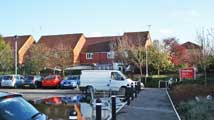
The north part of the site is occupied by a Tesco superstore and its car park.
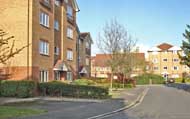
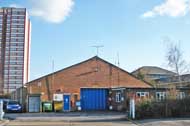
The south side contains pleasant housing (left). The only health activity is an ambulance station on the east side of the site (right).
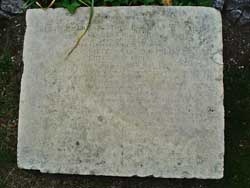
An almost illegible foundation stone for the Hospital laid by Princess Mary Adelaide, Duchess of Teck, on 28th July 1897. It is now located in the History Garden at the West Middlesex University Hospital.
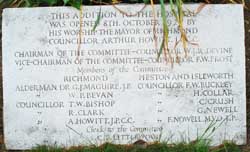
Also in the History Garden is the commemorative stone to the extension of the Hospital, laid by the Mayor of Richmond on 8th October 1927.
Mogden was the old name for part of south Isleworth.
In 1936 a large sewage treatment plant was built for the West Middlesex drainage district on Mogden Farm. It replaced 28 small sewage works in north and west London. Covering 120 acres of land, the Mogden Sewage Treatment Works has become of the largest sewage treatment plants in southeast England and now treats the effluent of about 1.8 million people. Residents have complained for many years about the smell sometimes emanating from the Works, which is known locally as the Mogden Pong.
The area is rarely called Mogden now, perhaps because of its association with the Works. It is known as Ivybridge.
http://edithsstreets.blogspot.co.uk
http://en.wikipedia.org
www.aim25.ac.uk
www.bbc.co.uk
www.hidden-london.com
www.nationalarchives.gov.uk
Return to home page